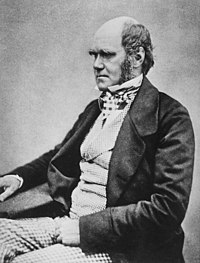Deyyaz/Academia portal trial
Selected article
He published his theory with compelling evidence for evolution in his 1859 book On the Origin of Species. The scientific community and much of the general public came to accept evolution as a fact in his lifetime. However, it was not until the emergence of the modern evolutionary synthesis from the 1930s to the 1950s that a broad consensus developed that natural selection was the basic mechanism of evolution. In modified form, Darwin's scientific discovery is the unifying theory of the life sciences, explaining the diversity of life.
Darwin's early interest in nature led him to neglect his medical education at the University of Edinburgh; instead, he helped to investigate marine invertebrates. Studies at the University of Cambridge encouraged his passion for natural science. His five-year voyage on HMS Beagle established him as an eminent geologist whose observations and theories supported Charles Lyell's uniformitarian ideas, and publication of his journal of the voyage made him famous as a popular author.
Puzzled by the geographical distribution of wildlife and fossils he collected on the voyage, Darwin investigated the transmutation of species and conceived his theory of natural selection in 1838. Although he discussed his ideas with several naturalists, he needed time for extensive research and his geological work had priority. He was writing up his theory in 1858 when Alfred Russel Wallace sent him an essay which described the same idea, prompting immediate joint publication of both of their theories. Darwin's work established evolutionary descent with modification as the dominant scientific explanation of diversification in nature. In 1871, he examined human evolution and sexual selection in The Descent of Man, and Selection in Relation to Sex, followed by The Expression of the Emotions in Man and Animals. His research on plants was published in a series of books, and in his final book, he examined earthworms and their effect on soil.
Selected biography
The page "User:Deyyaz/Academia portal trial/Selected biography/2" does not exist.
In the news
Selected picture
The page "User:Deyyaz/Academia portal trial/Selected picture/1" does not exist.
Did you know?
- ... that Mammotrectus super Bibliam, a guide book to understanding the Bible, was popular in the 15th century, but was criticized in the 16th century?
- ... that the 15th-century Treatise of Love is based on the 13th-century monastic manual Ancrene Wisse, but shows considerably less interest in carnal love?
- ... that Princess Ennigaldi, daughter of the last Neo-Babylonian king Nabonidus, created the world's first museum (ruins pictured)?
- ... that an annual award is given in honor of the Georgia old-time craftsman and blacksmith Alex W. Bealer, author of The Art of Blacksmithing?
- ... that acquisitions whilst Christopher Wright was Head of Manuscripts at the British Library included the archives of Punch magazine and that of Sir Arthur Conan Doyle?
Notes
Categories
Topics
Related portals
WikiProjects
Things to do

